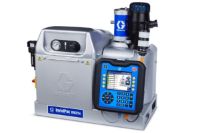Create a Safer Hot Melt Environment
Traditional hot melt systems can make adhesive application the most dangerous part of your packaging line – and hot melt adhesive safety crucial to your work environment and productivity.
4 Steps to Better Packaging Line Safety
Traditional hot melt systems use a tank to melt and keep the adhesive at operating temperature. Packaging line operators need to manually monitor tank levels and load new adhesive. Such direct access easily puts them at risk of injures and breathing problems, due to heated areas, molten adhesive, and toxic fumes.
Here are four steps you can take to improve hot melt adhesive safety on your packaging line.
1. Limit Exposure to Molten Adhesive
Hot melt-related burns easily occur whenever operators have direct access to the molten adhesive. To reduce their exposure and improve their working conditions, the best thing to do is implement a closed system into your packaging process.
A closed system eliminates direct access to the melting chamber, reducing the chance of burns.
2. Implement an Automated Feed System
Automated feed systems can add several benefits to packaging processes. For packaging line safety, the biggest wins are made when operators don’t need to manually fill hot melt tanks.
An automated feed allows operators to fill a separate, unheated container with un-melted adhesive pellets. The feeding system transfers the pellets into the melter as needed.
No contact with a heated metal tank or hot melt adhesive greatly reduces the potential of safety incidents and costly worker compensation claims. Using an automated feeding system also lessens the chance of pellets "bridging" and clumping together when spilled on the floor, where operators and other workers are likely to trip or fall.
3. Reduce Char Formation
Char is made when hot melt adhesive is overheated, contaminated or oxidized. It releases toxic fumes that operators breathe in when they come in contact with the hot melt.
There are two ways to reduce char formation and improve packaging line safety:
- Consistently clean char buildup in tank-based systems
- Switch to a tank-free system that eliminates char
4. Lower Pressure Before Maintenance
A depressurizing valve allows operators or maintenance workers to reduce the pressure in a hose or gun. This is critical in order for the system to be handled safely without the risk of hot melt exposure.
It is also important to consider the safety features of other equipment on your packaging line. For example, including a built-in over-temperature safety interlock and ensuring the air filter can be changed easily on applicators lessen the risk of the operator coming in contact with hot melt.
Related Articles
Global Food Company Improves Safety and Sustainability
The correct amount of adhesive at the right time and temperature is key to productivity and safety on automated packaging lines.
Improve Hot Melt System Performance
Explore how to increase the working uptime of your packaging line by improving the efficiency of hot melt adhesive application.
Comparing the Operation of Hot Melt Systems
Comparing how tank-based, tank-less, and Tank-Free systems work at each step of the hot melt process can help you determine which technology best suits your packaging operation.




